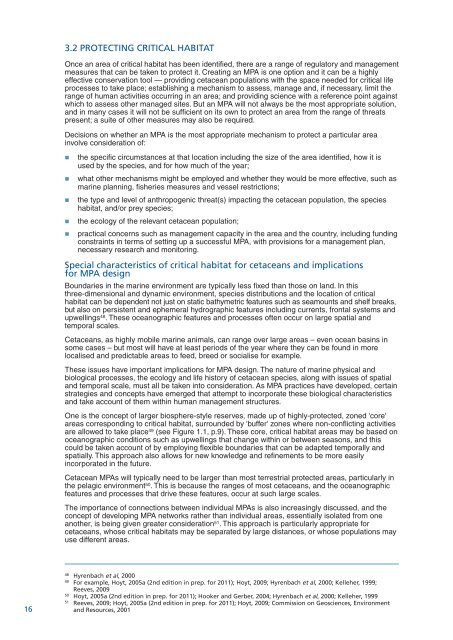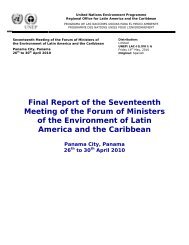English - Caribbean Environment Programme
English - Caribbean Environment Programme
English - Caribbean Environment Programme
- No tags were found...
Create successful ePaper yourself
Turn your PDF publications into a flip-book with our unique Google optimized e-Paper software.
3.2 PROTECTING CRITICAL HABITATOnce an area of critical habitat has been identified, there are a range of regulatory and managementmeasures that can be taken to protect it. Creating an MPA is one option and it can be a highlyeffective conservation tool — providing cetacean populations with the space needed for critical lifeprocesses to take place; establishing a mechanism to assess, manage and, if necessary, limit therange of human activities occurring in an area; and providing science with a reference point againstwhich to assess other managed sites. But an MPA will not always be the most appropriate solution,and in many cases it will not be sufficient on its own to protect an area from the range of threatspresent; a suite of other measures may also be required.Decisions on whether an MPA is the most appropriate mechanism to protect a particular areainvolve consideration of:the specific circumstances at that location including the size of the area identified, how it isused by the species, and for how much of the year;what other mechanisms might be employed and whether they would be more effective, such asmarine planning, fisheries measures and vessel restrictions;the type and level of anthropogenic threat(s) impacting the cetacean population, the specieshabitat, and/or prey species;the ecology of the relevant cetacean population;practical concerns such as management capacity in the area and the country, including fundingconstraints in terms of setting up a successful MPA, with provisions for a management plan,necessary research and monitoring.Special characteristics of critical habitat for cetaceans and implicationsfor MPA designBoundaries in the marine environment are typically less fixed than those on land. In thisthree-dimensional and dynamic environment, species distributions and the location of criticalhabitat can be dependent not just on static bathymetric features such as seamounts and shelf breaks,but also on persistent and ephemeral hydrographic features including currents, frontal systems andupwellings 48 . These oceanographic features and processes often occur on large spatial andtemporal scales.Cetaceans, as highly mobile marine animals, can range over large areas – even ocean basins insome cases – but most will have at least periods of the year where they can be found in morelocalised and predictable areas to feed, breed or socialise for example.These issues have important implications for MPA design. The nature of marine physical andbiological processes, the ecology and life history of cetacean species, along with issues of spatialand temporal scale, must all be taken into consideration. As MPA practices have developed, certainstrategies and concepts have emerged that attempt to incorporate these biological characteristicsand take account of them within human management structures.One is the concept of larger biosphere-style reserves, made up of highly-protected, zoned 'core'areas corresponding to critical habitat, surrounded by 'buffer' zones where non-conflicting activitiesare allowed to take place 49 (see Figure 1.1, p.9). These core, critical habitat areas may be based onoceanographic conditions such as upwellings that change within or between seasons, and thiscould be taken account of by employing flexible boundaries that can be adapted temporally andspatially. This approach also allows for new knowledge and refinements to be more easilyincorporated in the future.Cetacean MPAs will typically need to be larger than most terrestrial protected areas, particularly inthe pelagic environment 50 . This is because the ranges of most cetaceans, and the oceanographicfeatures and processes that drive these features, occur at such large scales.The importance of connections between individual MPAs is also increasingly discussed, and theconcept of developing MPA networks rather than individual areas, essentially isolated from oneanother, is being given greater consideration 51 . This approach is particularly appropriate forcetaceans, whose critical habitats may be separated by large distances, or whose populations mayuse different areas.1648Hyrenbach et al, 200049For example, Hoyt, 2005a (2nd edition in prep. for 2011); Hoyt, 2009; Hyrenbach et al, 2000; Kelleher, 1999;Reeves, 200950Hoyt, 2005a (2nd edition in prep. for 2011); Hooker and Gerber, 2004; Hyrenbach et al, 2000; Kelleher, 199951Reeves, 2009; Hoyt, 2005a (2nd edition in prep. for 2011); Hoyt, 2009; Commission on Geosciences, <strong>Environment</strong>and Resources, 2001
















